Tillage Machinery: Its Role and Impact in Agriculture

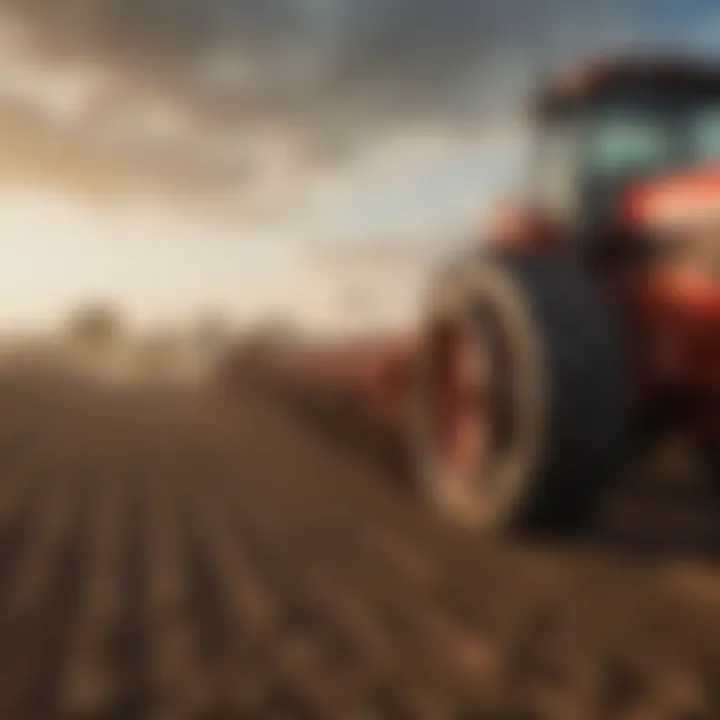
Intro
Tillage machinery plays a critical role in modern agriculture. This equipment not only prepares the soil but also impacts crop yields and soil health. By understanding the significance of tillage practices, farmers and agricultural professionals can make informed decisions that enhance productivity and sustainability in farming.
Topic Overview
Definition and Importance
Tillage refers to the agricultural preparation of soil by mechanical agitation. It involves turning over the soil, mixing in organic matter, and creating a suitable seedbed for planting. Tillage machinery, including plows, harrows, and cultivators, is essential for these processes. Its importance lies in its ability to improve soil structure, aerate the soil, and control weeds, pest, and diseases. Farmers rely on tillage to implement crop rotations and to create conditions that promote healthy plant growth.
Brief History and Evolution
Historically, tillage practices date back thousands of years, with early methods using hand tools and basic implements. The Industrial Revolution led to substantial advancements. In the 19th century, the introduction of the steel plow by John Deere revolutionized tillage practices. Over the decades, the equipment evolved from animal-drawn implements to complex machinery operated by tractors. Today, precision agriculture has brought forth technologies like GPS-guided tractors, enhancing efficiency further.
Key Techniques and Innovations
Sustainable Farming Practices
As agriculture evolves, there is a growing emphasis on sustainability. Farmers are exploring reduced tillage and conservation tillage practices to preserve soil health. These methods help reduce soil erosion, enhance organic matter retention, and support biodiversity in soil ecosystems. By minimizing disturbance, farmers can maintain soil structure and improve water retention.
Advanced Agronomic Technologies
The integration of technology in tillage has led to more efficient practices. Innovations such as variable rate tillage and soil moisture sensors allow farmers to tailor their tillage operations to field conditions. This not only optimizes fuel usage but also maximizes crop performance. Many manufacturers are applying smart technology to machinery, ensuring better tracking and management of tillage equipment.
Practical Applications
Step-by-Step Guides
When considering the implementation of new tillage machinery, farmers can follow these steps:
- Assess the requirements of the soil: Conduct soil tests to understand the nutrient levels and structure.
- Choose the appropriate tillage system: Select between conventional, reduced, or no-tillage based on the soil’s needs.
- Select suitable machinery: Evaluate the specific machines that meet the chosen tillage system’s requirements.
- Implement best practices: Follow operational guidelines for machinery use to ensure efficiency and effectiveness.
Case Studies or Real-World Examples
A notable example is the adoption of no-till practices in the United States. Farmers in states such as Ohio and Indiana have significantly increased corn and soybean yields through no-till farming. This method not only enhances soil health but also reduces labor and machinery costs, proving beneficial for both the environment and the farmer’s bottom line.
"Adopting improved tillage methods is not merely an option; it is a necessity for sustainable agriculture now and in the future." - Agricultural Expert
Through continuous improvement and adaptation, the role of tillage machinery in agriculture remains vital. This evolution signifies the necessity for all involved in agriculture to stay informed about advancements and practices that ensure a productive and sustainable future.
Prelude to Tillage Machinery
Tillage machinery plays a crucial role in modern agriculture, shaping the way soil is prepared for planting. Its use determines not only the efficiency of farming practices but also has significant impacts on soil health and crop yield. Understanding tillage machinery encompasses a range of tools and techniques that are indispensable to contemporary farming.
The benefits of using advanced tillage equipment cannot be overstated. These machines enable farmers to improve soil aeration, manage weed populations, and prepare seedbeds that promote optimal growth conditions. With various types of tillage machinery available, farmers have the ability to select the right equipment suited for their specific soil conditions, crops, and desired outcomes.
In recent years, the discussion around tillage has also included considerations about sustainability. Farmers are increasingly aware that tillage methods can impact soil structure, erosion potential, and biodiversity. As a result, there is a growing shift toward methods that minimize soil disturbance, such as no-till farming. This has introduced new technologies and practices aimed to reduce the agricultural carbon footprint.
Moreover, tillage machinery is not static; it is continually evolving. Advancements in technology have led to precision tillage techniques, where farmers can utilize data-driven approaches to enhance efficiency. Tools equipped with sensors and automation streamline operations and contribute to better resource management.
Overall, the significance of tillage machinery extends beyond simple soil preparation. It integrates with broader agricultural practices and sustainability goals, making it an essential topic for farmers and agronomists alike.
The ongoing developments in tillage technology reflect the agricultural sector’s commitment to optimizing productivity while considering environmental impact.
Historical Context of Tillage Practices
The historical context of tillage practices provides essential insights into the evolution of agriculture itself. Understanding how tillage machinery has developed over time helps us appreciate its current role in sustainable farming. Tillage methods have greatly influenced soil health, agricultural productivity, and, ultimately, food security. The journey from primitive practices to advanced mechanized systems highlights significant innovations and shifts in agricultural philosophy. These historical trends also reflect our growing awareness of environmental impacts, shaping modern agricultural strategies.
Evolution of Tillage Tools
The evolution of tillage tools reveals extensive changes in our approach to farming. In ancient times, farmers utilized simple hand tools such as hoes and forks to till the soil. These objects were labor-intensive and limited in their impact on large fields. The innovation of plows, which emerged around 3000 BC, marked a pivotal change. Early plows were made of wood and required animal power, increasing efficiency in soil preparation.
Over centuries, plows underwent various transformations. The introduction of the iron plowshare in the Middle Ages allowed for deeper penetration of the soil. As technology advanced, farmers began using metal components and more complex designs that enabled improved aeration and soil mixing. Today, modern plows, often constructed from durable steel and designed for specific soil types, are available in multiple forms. These devices enable precise control over soil conditions, showcasing how innovation continues to enhance agricultural effectiveness.
Transition from Manual to Mechanical Tillage
The transition from manual to mechanical tillage represents a fundamental shift in agricultural practices. In the 19th century, the Industrial Revolution catalyzed this transformation. The introduction of steam-powered tractors marked the beginning of a new era. Farmers began to rely on machinery, increasing productivity and efficiency on a scale previously unimaginable.
The adoption of gasoline and diesel-powered tractors in the early 20th century further accelerated this process. With machinery, farmers could cultivate larger areas of land with less physical effort. This shift also allowed for more precise timing in tillage operations, which is critical for crop health.
However, this transition was not without challenges. Machine maintenance, initial costs, and the need for skilled operators became new considerations for farmers. Despite these challenges, the benefits of mechanical tillage have dominated discussions about modern agriculture, leading to increased yields and more sustainable practices in many cases.
"The transition to mechanical tillage is one of the most significant advancements in agricultural history, revolutionizing the way farming is conducted and impacting food systems globally."
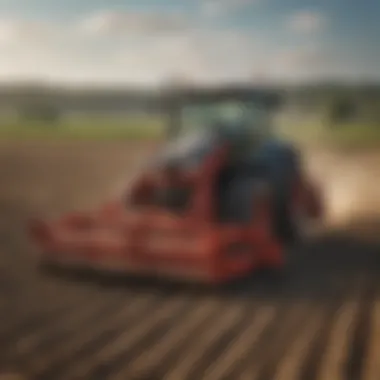
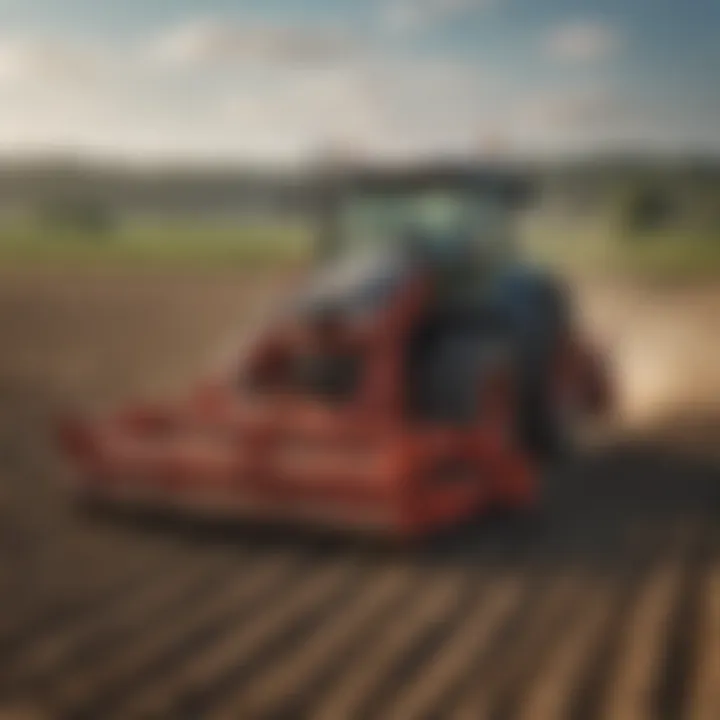
Types of Tillage Machinery
The realm of tillage machinery is crucial in modern agriculture. Each type of machinery serves a specific purpose that contributes to soil preparation and cultivation. Understanding these types enables farmers to choose the right tools for their needs, enhancing efficiency and productivity.
Plows: The Foundational Tool
Plows are often considered the cornerstone of tillage practices. Their primary role is to turn over the soil, burying crop residues, and breaking up compacted earth. By doing this, plows promote aeration and help manage weeds. Various types of plows exist, such as moldboard, chisel, and disc plows. Each has unique attributes suited for different soil types and conditions. Moldboard plows are best for deeper tillage, while chisel plows are used for less disturbance. This versatility makes plows essential for optimal soil management.
Harrows: Preparing for Planting
Harrows follow plows in the tillage sequence. They are important for leveling and smoothing the soil surface after plowing. Harrowing breaks up clods and prepares a fine seedbed. There are different designs of harrows, including drag harrows and tine harrows. Using harrows before planting can improve seed-to-soil contact, enhancing germination rates. Additionally, they help incorporate fertilizers and organic matter into the soil, ensuring a richer growing environment for crops.
Seeders and Planters: Precision in Sowing
Seeders and planters represent the precision aspect of tillage machinery. These tools are designed to sow seeds at specific depths and spacing, which is vital for crop success. Planters often come equipped with technologies that optimize seeding rates and incorporate fertilizers at the same time. This capability leads to better resource management and crop establishment. The precision in sowing helps minimize waste and maximizes yield potential, making them important in modern farming strategies.
Cultivators: Managing Weeds and Soil Condition
Cultivators play a significant role in maintaining soil health and controlling weeds. They work the soil in between planting rows, helping to aerate the soil and disrupt weed growth. This prevents weeds from competing with crops for nutrients and water. There are various cultivator types, such as spike-tooth and rotary cultivators. Each type serves different soil conditions and crop types. By controlling weeds and improving soil conditions, cultivators contribute positively to overall crop management.
Tillage Techniques and Operations
Tillage is a crucial aspect of modern agriculture that significantly influences soil management, crop productivity, and the health of the ecosystem. Understanding various tillage techniques and their operations is key to optimizing agricultural practices. Each method has distinctive features, and selecting the right one can lead to improved yields and sustainable farming.
Conventional Tillage
Conventional tillage is the traditional approach to preparing the soil for planting. This technique involves turning over the top layer of soil, incorporating crop residues into the ground. The primary purpose of conventional tillage is to create a fine seedbed for the crops. While it can effectively kill weeds and pests, this technique may lead to several challenges.
One of the notable drawbacks is soil erosion. Frequent disturbance of the soil structure can increase its vulnerability to erosion by wind and water. Additionally, the consistent turning of the soil disrupts the natural habitats of microorganisms that are essential for soil health. Farmers often find that while short-term benefits like enhanced weed control are clear, the long-term implications require careful management practices.
Reduced Tillage
Reduced tillage, also known as conservation tillage, aims to minimize soil disturbance while preparing for planting. This method retains more residue on the surface, which offers protective benefits such as reducing erosion and maintaining soil moisture.
The advantages of reduced tillage are evident. It supports soil structure and organic matter levels, which enhance biodiversity in the soil. Moreover, reduced tillage can lead to lower fuel and labor costs due to less intensive operations. A primary consideration, however, is the adjustment period. Farmers transitioning to reduced tillage may face a learning curve in managing crops effectively under this system. It's important to monitor soil health continuously to reap the full benefits.
No-Till Farming: A Sustainable Approach
No-till farming represents a paradigm shift in agricultural practices. In this method, the soil is left undisturbed, except for the necessary planting. This technique promotes sustainability by significantly minimizing soil erosion, improving moisture conservation, and enhancing soil fertility.
By preserving the soil structure, no-till systems support greater biological activity and nutrient cycling, which are essential for healthy crops. Additionally, since no-till practices require less manpower and equipment, farmers can lower their operational costs, making it financially viable.
"No-till methods have been shown to contribute to increased biodiversity, enhancing ecosystem services while simultaneously improving crop yields."
Yet, adopting no-till farming does not come without challenges. Farmers must invest in specialized equipment for planting directly into the residue and may need to alter their approach to weed management. Proper initial implementation and continuous evaluation are critical to achieving the desired outcomes.
Soil Health and Tillage
Soil health is a crucial aspect of tillage machinery's impact on modern agriculture. Understanding how tillage techniques affect soil composition and life is essential for farmers wanting to maximize agricultural productivity while maintaining ecological balance. This section discusses how different tillage methods influence the physical and chemical properties of soil, as well as its biological activity.
Impact on Soil Structure
Tillage activities directly influence soil structure. When soil is tilled, it can become overly loose or compacted, depending on the method used. Conventional tillage breaks down soil aggregates, contributing to finer soil particles that often lead to erosion. However, reduced or no-till practices can help maintain the natural structure of soil, enabling better air circulation and water absorption.
A well-structured soil has the following benefits:
- Improved drainage reduces waterlogging, which can harm crops.
- Enhanced root development allows plants to access nutrients more effectively.
- Increased biodiversity supports various microorganisms, which are vital for soil fertility.
Farmers must assess their tillage strategies to promote a desired soil structure, ensuring long-term agricultural success while mitigating potential negative consequences.
Nutrient Management Considerations
Nutrient management in the context of tillage practices is equally vital. Different tillage systems have varied effects on nutrient availability in the soil. Conventional tillage may lead to nutrient depletion due to erosion and runoff, while sustainable practices like no-till farming can help conserve soil nutrients.
Key considerations include:
- Soil testing: Regular testing informs farmers about nutrient levels, allowing them to adjust their applications accurately.
- Cover cropping: This method can improve nutrient retention and cycling, especially in no-till systems.
- Organic amendments: Adding compost or manure can enhance soil fertility and support microbial life.
Farmers can enhance soil health by integrating effective nutrient management strategies into their tillage practices. The goal is not only to boost productivity but also to sustain the soil ecosystem for future generations.
"Sustainable farming practices play a vital role in maintaining soil health, ensuring crop yield longevity, and enhancing the environmental resilience of agricultural systems."
Advancements in Tillage Technology
The evolution of tillage technology signifies a critical advance in modern agriculture. This section will discuss the significance of recent developments and how they are transforming farming practices. These advancements reflect a move towards efficiency, sustainability, and increased crop yield. Both farmers and enthusiasts will find this information beneficial for understanding the context and impact of these changes in tillage methods.
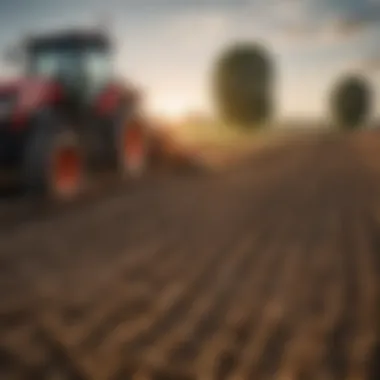
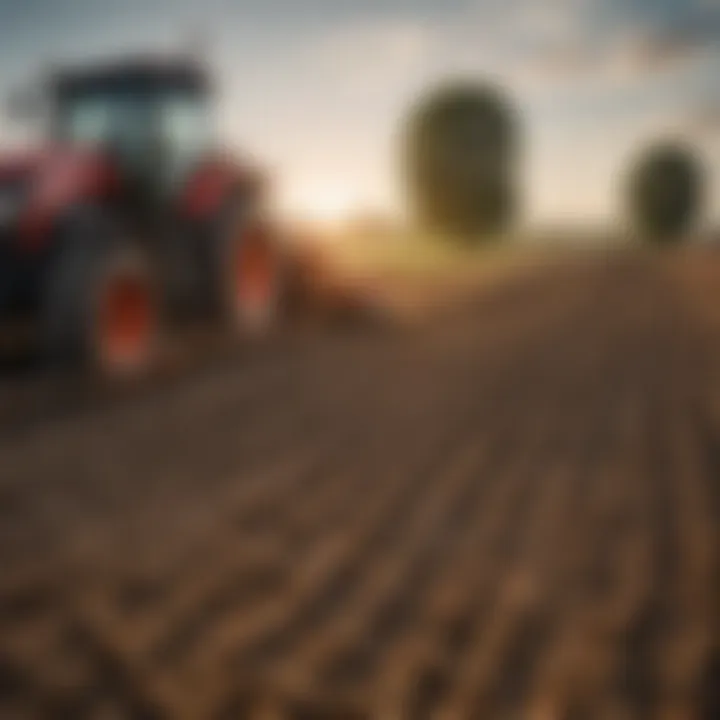
Automation and Precision Agriculture
Automation has become an essential element of modern tillage technology. By integrating sophisticated machinery with the use of sensors and GPS technology, farmers can achieve much higher accuracy in their operations. This leads to numerous advantages:
- Resource Optimization: Automation reduces the excess use of seeds, fertilizers, and water. This ensures that crops receive precisely what they need, enhancing growth while minimizing waste.
- Labor Efficiency: There is a decreased reliance on manual labor, which can be scarce in some regions. Automated systems can operate with minimal human intervention, allowing farmers to focus on more strategic aspects of farming.
- Data-Driven Decisions: Precision agriculture tools collect vast amounts of data on soil conditions, moisture levels, and crop health. Analyzing this data helps farmers make informed decisions for future planting and operational adjustments.
These advancements not only increase efficiency but also align with sustainable practices in agriculture. As automation continues to grow, the role of traditional farming methods is likely to change, urging a need for ongoing education and adjustment among farmers.
Sustainable Equipment Innovations
Another significant trend in tillage technology is the focus on sustainable equipment innovations. Traditional tillage methods can lead to soil degradation and adverse environmental effects. In contrast, newer machinery aims to minimize these impacts:
- Reduced Soil Disturbance: Equipment designed for minimal soil disturbance maintains soil structure and health. Tools like strip-tillage and vertical tillage reduce the amount of soil turned over, preserving beneficial microorganisms in the ecosystem.
- Adaptive Machinery: Innovations such as variable rate technology allow farmers to adjust equipment settings based on field variability. This adaptability ensures optimal conditions for crops while preventing unnecessary impacts on the environment.
- Biodegradable Options: Some manufacturers are beginning to explore alternative materials for building tillage tools. By using biodegradable plastics or recycled materials, the agricultural industry can substantially decrease its carbon footprint.
As the need for environmentally conscious farming practices grows, investments in sustainable equipment will play a critical role. Farmers who adopt these innovations not only benefit their land and crops but can also appeal to a market increasingly focused on sustainability.
"Advancements in tillage technology are not just about efficiency; they encapsulate a broader shift towards sustainability and conservation in agriculture."
The incorporation of automation and sustainable equipment presents a promising direction for the agriculture sector. Embracing these changes holds the potential for improved productivity, reduced environmental impact, and enhanced long-term viability in farming.
Economic Implications of Tillage Practices
The economic implications of tillage practices is a pivotal topic in the realm of modern agriculture. Understanding how different tillage methods affect costs and productivity can guide farmers in making informed decisions. As pressures increase on agronomic systems, both from a financial and environmental perspective, the choice between conventional and sustainable tillage methods becomes critical.
Investing in tillage machinery has both short-term and long-term economic consequences. Initial capital outlay for equipment can be significant. Farmers often grapple with whether to invest in traditional machinery or adopt new, sustainable approaches. This decision-capable of affecting farm viability weighs heavily on most agricultural professionals.
Additionally, correlating tillage practices with crop yields can clarify the financial landscape. Effective tillage can enhance soil quality, leading to better yields and reduced expenses on inputs such as fertilizers and herbicides. Conversely, poor tillage decisions may negatively impact the economy of farming operations due to reduced productivity and increased infrastructural costs.
Cost Analysis: Conventional vs. Sustainable Methods
When examining the cost analysis between conventional and sustainable tillage methods, clear distinctions emerge. Conventional tillage often necessitates significant investment in machinery that can be expensive to maintain and operate. Farmers may spend considerable money on fuel, repair parts, and labor.
Some costs associated with conventional tillage include:
- Fuel: Traditional tillage techniques generally require more energy.
- Labor: The labor needed for operational monitoring can be higher.
- Maintenance: Wear and tear on machinery can lead to increased maintenance needs.
On the other hand, sustainable practices, such as no-till farming, often have lower operational costs in the long run. Here are key expenses to consider:
- Initial Investment: Often less for no-till equipment.
- Input Costs: Reduced need for fertilizers and herbicides, leading to lower expenses.
- Labor Savings: Less labor is needed when applying sustainable practices, with fewer field operations.
Evaluating these factors helps farmers decide based on both the initial investment and the long-term economic impacts of their tillage choices.
Long-term Benefits of No-Till Practices
The long-term benefits of no-till practices are increasingly recognized among farmers and agronomists alike. Not only do these practices support environmental sustainability, but they also contribute positively to the economic stability of agricultural businesses.
Some of the key benefits include:
- Improved Soil Health: No-till farming increases soil organic matter, which enhances nutrient retention and biodiversity. Healthier soil can lead to higher yields over time.
- Reduced Erosion: By minimizing soil disturbance, no-till practices help protect the topsoil, reducing loss due to wind and water erosion.
- Lower Input Costs: Farmers practicing no-till often benefit from reduced requirements for chemical fertilizers and herbicides, leading to substantial direct cost savings.
- Enhanced Crop Resilience: Healthy soils support better crop resilience to pests and erratic weather patterns, ultimately promoting more consistent yields.
Furthermore, adopting no-till practices can lead to a stronger market position for farmers seeking organic certifications or environmentally friendly products, which can attract premium prices for their crops.
The transition toward sustainable tillage methods also positions farming to face future market demands, where sustainability is increasingly prioritized in consumer choices.
Environmental Considerations
The growing awareness of environmental issues has significantly shaped the discourse on agricultural practices, particularly in relation to tillage machinery. This section explores how tillage operations not only influence agricultural productivity but also impact broader environmental dynamics. Understanding these intersections is crucial, as modern agriculture navigates the complexities of sustainability and ecological balance.
Carbon Sequestration through Tillage
Carbon sequestration is a vital process where carbon dioxide is captured from the atmosphere and stored in the soil. Tillage practices play a dual role in this regard. On one hand, traditional tillage tends to release carbon back into the atmosphere due to soil disturbance. On the other, adopting no-till or reduced-till methods can enhance carbon storage.
Research indicates that soils under no-till management can store significantly more carbon compared to those routinely plowed. This is due to the preservation of organic matter and soil structure, helping to create a more stable environment for carbon storage. Farmers can implement measures such as cover cropping and reduced disturbance to optimize carbon sequestration.
"The adoption of sustainable tillage practices can sequester over 100 million metric tonnes of carbon dioxide annually in the United States alone."
The benefits are clear: Increased carbon sequestration not only aids in mitigating climate change but also enhances soil health, leading to better crop yields over time. As such, tillage machinery's role in promoting sustainable practices becomes ever more significant.
Water Conservation Techniques
Water management is another critical factor within environmental considerations in agriculture. Tillage affects the soil's ability to retain moisture, a crucial element for crop health. Different tillage methods influence how water infiltrates the soil and how much is lost through evaporation.
No-till farming mimics natural processes and thus improves water retention. By reducing surface disturbance, farmers can enhance the soil's structure, allowing it to absorb and store more water. This is particularly important in arid regions, where every drop counts. Some practices that support water conservation include:
- Cover Cropping: This helps protect the soil from erosion and retains moisture.
- Contour Farming: This method involves plowing across the slope of the land, which helps reduce water runoff.
- Using Organic Mulch: Adding organic materials can reduce evaporation rates and keep the soil moist longer.
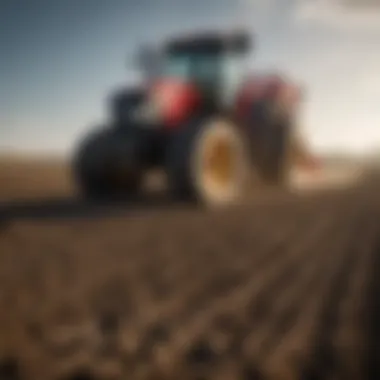
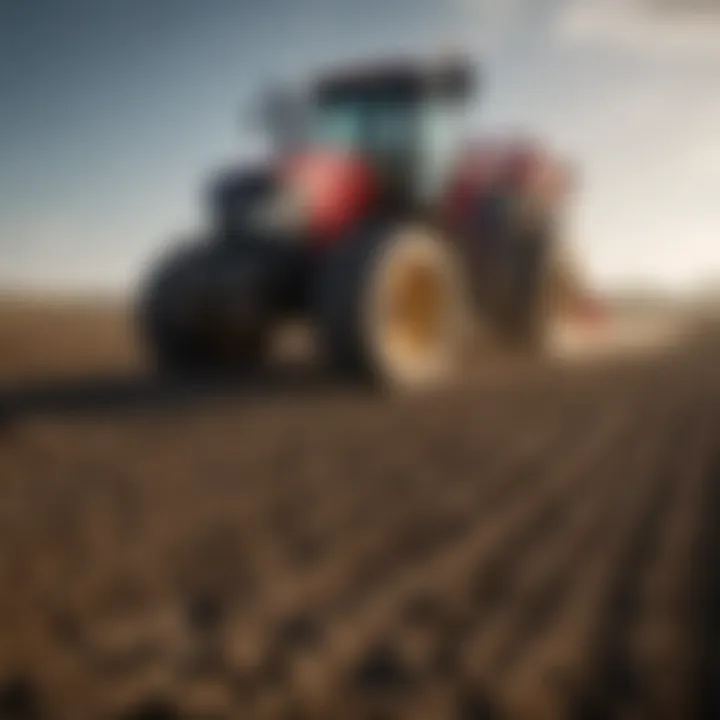
These techniques not only optimize water usage but also contribute to healthier soil ecosystems. As water scarcity becomes an increasing concern, understanding the relationship between tillage practices and water conservation will be essential for sustainable agriculture moving forward.
Case Studies and Practical Applications
Understanding the practical applications of tillage machinery through case studies provides a vital perspective on its relevance in modern farming. Real-world examples show how different tillage practices can affect productivity and sustainability. These studies often highlight successful strategies and learning outcomes that can be replicated across various agricultural contexts. By analyzing these case studies, farmers can gain insights into adaptive practices that address local challenges, such as soil degradation and resource management.
Successful No-Till Farm Operations
No-till farming is increasingly recognized for its environmental and economic benefits. This approach minimizes soil disturbance, leading to improved soil health and moisture retention. A notable case is the operation of large-scale no-till farms across the Midwest of the United States. These farmers report increased yields and reduced input costs through a well-managed no-till system. In one example, a farmer transitioned from conventional tillage to no-till and documented a significant decrease in fuel and labor costs. This practice reduces erosion and promotes biodiversity by preserving the soil structure.
Farmers interested in transitioning to no-till may consider the following:
- Adoption of Cover Crops: Utilizing cover crops in rotation can suppress weeds and enhance soil fertility.
- Proper Equipment: Using specialized no-till seeders allows for effective planting without disturbing the soil.
- Data-Driven Decisions: Monitoring soil health and moisture levels contributes to informed management strategies.
Innovative Use of Tillage Equipment in Different Climates
The adaptability of tillage equipment is crucial for successful farming in diverse climates. Farmers in warmer regions often face challenges such as drought and soil erosion. Innovative use of tillage machinery, like adaptive tillage systems, helps mitigate these issues. For instance, in Brazil, farmers combine strip-till and no-till techniques to create optimal planting conditions in varying weather patterns.
Some key strategies include:
- Precision Tillage Technology: Equipment that adjusts to soil conditions can optimize planting and reduce waste.
- Integrated Crop Management: Combining tillage with other agronomic practices can enhance resilience against climate variability.
- Local Research and Development: Engaging in local agricultural innovation helps tailor tillage practices to specific climatic challenges.
By studying these various approaches, farmers can draw valuable lessons to enhance their own practices. As the agricultural sector navigates the complexities of modern challenges, these case studies serve as a compelling guide for both new and seasoned practitioners.
Challenges and Limitations of Tillage Machinery
Understanding the challenges and limitations of tillage machinery is crucial in the context of modern agricultural practices. While these machines play a significant role in enhancing productivity and efficiency, they also come with specific drawbacks that farmers need to consider. Addressing these challenges can lead to better decision-making and sustainable farming practices.
Soil Compaction Issues
Soil compaction is one of the most pressing issues related to tillage machinery. When farmers use heavy machines, the weight can compress the soil particles. This leads to various problems, such as reduced pore space for air and water movement. Soil compaction can hinder root growth, and this can significantly affect crop yield. When the roots struggle to penetrate the soil, plants become weaker and more susceptible to diseases. The prevention of soil compaction is critical.
To mitigate this problem, farmers can adopt several strategies:
- Use lighter machinery: Utilizing lighter tillage equipment or optimizing the weight of existing machines can help reduce compaction.
- Implement controlled traffic farming: This practice limits the areas where heavy equipment travels, allowing untouched areas to maintain better soil structure.
- Choose appropriate tillage techniques: Alternating between conventional and conservation tillage methods may offer a solution.
Recognizing these soil compaction issues is vital for long-term agricultural success. Proper management will ensure that the soil maintains its fertility and health.
Economic Viability for Small Farms
The economic viability of tillage machinery poses another significant challenge, especially for small farms. Investing in high-quality tillage equipment can be prohibitively expensive for smaller operations. These farms may find themselves operating on tight budgets with limited access to financial resources. Therefore, the cost-benefit analysis of purchasing or leasing machinery is essential.
The economic considerations may include:
- Initial investment costs: The price of new tillage machinery can be daunting, and depreciation over time must also be considered.
- Maintenance and operational costs: Ongoing expenses such as fuel, repairs, and even labor must be relevant.
- Return on investment: Farmers should evaluate if the productivity improvements from the machinery justify the high initial capital.
For small farms, adopting no-till or reduced tillage methods can be cost-effective in the long run. These practices generally require less equipment investment and lead to lower operational costs.
Understanding these economic aspects is important for farmers who want to maximize their resources while effectively managing their farming operations. This knowledge helps in creating strategies that can lead to sustainable and profitable agriculture in today's complex environment.
Managing the challenges associated with tillage machinery is essential for maintaining soil health and economic viability in modern farming. - An experienced agriculturalist
Future of Tillage in Agriculture
The future of tillage in agriculture is a topic of increasing relevance in today's rapidly evolving agricultural landscape. With the push towards sustainability, farmers and agricultural professionals must adapt to new technologies and practices that promise greater efficiency and less environmental impact. This section will discuss the emerging trends enshrined in the future of tillage, including advancements in machinery and the influence of policy on farming practices.
Trends in Farming Technology
The integration of technology in agriculture marks a significant milestone for tillage practices. Modern tillage machinery is now equipped with advanced features that enhance efficiency and precision. For instance, automated tillage equipment employs sensors and GPS technology to optimize soil treatment and minimize wastage. Farmers can analyze soil conditions in real-time, thus making informed decisions that lead to higher yields.
Furthermore, precision agriculture has a strong hold on the future of tillage. This approach allows for tailored farming practices, which include variable rate application of fertilizers and precise soil management strategies based on data collection. Such fine-tuning reduces input costs, protects biodiversity, and improves overall soil health. The shift to smart machinery is indicative of the trend toward automation that seeks to help farmers manage their fields more effectively while confronting labor shortages in the sector.
The Role of Policy in Tillage Practices
Effective policies play a crucial role in shaping the future of tillage practices. Governments and regulatory bodies need to recognize the importance of sustainable practices within agriculture. Policymakers are increasingly focusing on incentives for farmers to adopt conservation tillage methods, such as no-till farming, which helps maintain soil structure and reduces erosion.
Moreover, financial assistance programs can facilitate the acquisition of advanced tillage machinery. Access to funding encourages farmers to invest in newer technologies that prioritize environmental health. As climate change continues to present challenges to agriculture, supportive policies can also promote research into sustainable tillage methods that protect long-term agricultural productivity.
Ending
The conclusion of this article presents a vital synthesis of the elements discussed regarding tillage machinery. Understanding how tillage practices influence modern agriculture is essential for optimizing crop yields and ensuring sustainable farming methods.
Core Elements of Tillage Machinery
Tillage machinery serves multiple purposes, including soil preparation, weed management, and nutrient incorporation. Each type of equipment, from plows to seeders, has distinct functions that contribute significantly to agricultural efficiency. By analyzing these tools in detail, farmers can select the best equipment suited for their specific land and crops.
Benefits of Effective Tillage Practices
The direct impact on soil health cannot be understated. Proper tillage improves soil structure, enhances nutrient availability, and promotes better seed-to-soil contact. Incorporating practices such as no-till farming can even lead to increased carbon sequestration, benefiting the environment and mitigating climate change effects.
Considerations and Future Directions
As we move forward, attention must be given to economic viability and environmental sustainability. Innovations in tillage machinery, including automation and precision agriculture technologies, promise to enhance productivity while minimizing harm to the environment. Farmers need to stay informed about trends and policy changes that affect tillage practices to adapt effectively.
"The shift toward sustainable tillage is not just a trend; it's a necessity for the future of farming."
In essence, tillage machinery plays a significant role in the agriculture sector, influencing everything from soil health to crop yields. By understanding and improving the practices surrounding these machines, farmers can enhance their operations and contribute positively to the environment.



